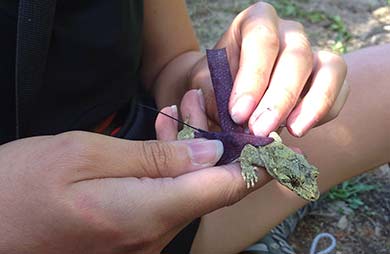Archived content: This media release was accurate on the date of publication.
Date: 12 February 2018
The ngahere geckos have come from GBC Winstone's Belmont Quarry via a three-year translocation programme. They are part of a radio tracking study to evaluate whether a penned release is likely to improve translocation success for the species.

The radio transmitters only weight 0.7 g and are attached with self-adhesive tape around the gecko’s chest
Image: Asha Fernandez | EcoGecko ©
DOC Science Advisor Jo Monks says the radio transmitters only weight 0.7 g and are attached with self-adhesive tape around the gecko's forelegs and chest, giving the effect of them wearing a backpack.
"Its quite a delicate process to attach the transmitters. We need to work quickly to avoid stress but also take time to ensure the fit is right, so it won't impede the animal's movements."
Nine new arrivals, plus an equal number of geckos which had been previously 'soft-released' – transferred and housed on the island, inside a large open pen – will be tracked for six weeks and their movements recorded nightly.
"What we have seen in research on other species is the previously penned animals don't travel far once the pen is removed, compared to the new arrivals which can disperse widely," says Jo.
"Ideally we want them to stick together. Otherwise some individuals may disperse too far and be unable to find each other again and contribute to a breeding population."
"So far, research has shown that a soft-release is a much more successful strategy for species like jewelled geckos. Trialling this conservation strategy with ngahere geckos will tell us whether it is useful for other groups of native geckos."
A total of 49 ngahere geckos have been transferred to Mana Island as part of a three-year project with the support of Ngati Toa and Friends of Mana Island.
GBC Winstones, which is a subsidiary of Fletcher Building, aimed to collect and transfer as many geckos as possible from future development areas of Belmont Quarry. The company is also contributing to pest control and replanting in the adjoining Belmont Regional Park, and protecting lizard habitat across 10 hectares of their land.
New Zealand has more than 110 species of geckos and skinks – almost half of which are threatened.
Offshore pest-free islands like Mana provide safe habitats for them as their natural habitat is reduced by urban development and they are preyed upon by rats, hedgehogs, cats and other introduced mammals.
Mana Island now boasts eleven species of native lizards.
